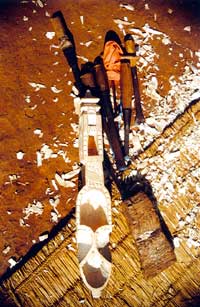 It's a long way from his home in Gorkha for 13-year-old Rubin Gandharba. He is in Kathmandu this week with a mission to revive the gaine musical tradition, established by his ancestors centuries ago. "People in the capital should know who we are and about our contribution to Nepali culture," says Rubin, who is joining 19 other gaines to participate in the three-day Gandhaba Festival in Patan starting 30 January.
It's a long way from his home in Gorkha for 13-year-old Rubin Gandharba. He is in Kathmandu this week with a mission to revive the gaine musical tradition, established by his ancestors centuries ago. "People in the capital should know who we are and about our contribution to Nepali culture," says Rubin, who is joining 19 other gaines to participate in the three-day Gandhaba Festival in Patan starting 30 January. 'Gandharba ka Saathiharu', a Kathmandu-based community of journalists and musicians, have come together to promote the music of the gaines, Nepal's travelling minstrels. In the caste system of cable and FM, this sublime music played to the wail of sarangi and beat of the madal falls at the bottom of the pecking order.
Most Nepali folk songs are inspired by the gaines. With them lies the genesis of Nepali folklore, song and music as we know it today. The modern folk genre is commercially successful but its proponents are predominantly Brahmins, Newars, Gurungs and Limbus. While neo-gaines gain nationwide popularity and become wealthy celebrities, the gaines are neglected and on the verge of extinction.
 Amrit Gurung, lead singer of Nepathya and Aavaas, a contemporary music composer and singer, went on a talent hunting mission to Kaski, Tanahu, Gorkha, Lamjung and Syangjha districts. Despite the accompanying danger of police harassment, bomb explosions and army-Maoist encounters, the two found 150 gaines and invited 20 to perform at the Gandharba Festival.
Amrit Gurung, lead singer of Nepathya and Aavaas, a contemporary music composer and singer, went on a talent hunting mission to Kaski, Tanahu, Gorkha, Lamjung and Syangjha districts. Despite the accompanying danger of police harassment, bomb explosions and army-Maoist encounters, the two found 150 gaines and invited 20 to perform at the Gandharba Festival. "It's sad that real musicians like them are not getting any opportunity at all. Nepali music will not advance by just copying the modern Western style but by modifying our own indigenous music," says Aavaas. Gaines are not just singers wandering around with four-string sarangis, but are communicators and reporters, keepers of the collective memory of our land. In the days before mass communication, their music was the medium for rural Nepal to learn of and remember battles, brave soldiers, natural disasters, joys and sorrows of everyday life.
The people listened attentively to the gaines and repaid their service with food, clothes and other necessities. Until just before the Maoist war flared up, when people were not as blas? about death as they are now, gaines composed songs about life's end. "But with so many deaths everyday, people are not shocked or even curious anymore," says Aavaas.
 Today most Nepalis view gaines as a nuisance-they are shooed away from bus windows, ignored on the city streets or humiliated by packs of young people. Frustrated by their waning popularity in the changing social sphere, alcoholism is on the rise among gaines. "Foreigners have done more for us than Nepalis. They have more respect and value for our music," says Krishna Bahadur Gandharba from Tanahu. He speaks of several gaines who were sponsored to travel abroad to participate in the folk music concerts. Lal Bahadur Gandharba went to Vienna two years ago and was surprised to get such a rousing round of applause from hundreds gathered to see him perform. "It was the happiest moment of my life," he recalls. "We should no longer be ashamed to say that we are gaines and of low caste."
Today most Nepalis view gaines as a nuisance-they are shooed away from bus windows, ignored on the city streets or humiliated by packs of young people. Frustrated by their waning popularity in the changing social sphere, alcoholism is on the rise among gaines. "Foreigners have done more for us than Nepalis. They have more respect and value for our music," says Krishna Bahadur Gandharba from Tanahu. He speaks of several gaines who were sponsored to travel abroad to participate in the folk music concerts. Lal Bahadur Gandharba went to Vienna two years ago and was surprised to get such a rousing round of applause from hundreds gathered to see him perform. "It was the happiest moment of my life," he recalls. "We should no longer be ashamed to say that we are gaines and of low caste." The old generation says it is up to the young to keep tradition alive. "First of all, they should not be ashamed to carry their sarangi and sing anywhere," says Krishna, who has given up trying to motivate children from a 17-member clan to follow his footsteps. Krishna feels the only way to prevent his people's music from becoming extinct is to document the gaines knowledge and skills.
Gandharba Festival
30 January - 1 February 2004 at Yala Maya Kendra,
Patan Dhoka Contact: 5522113, 2110200


